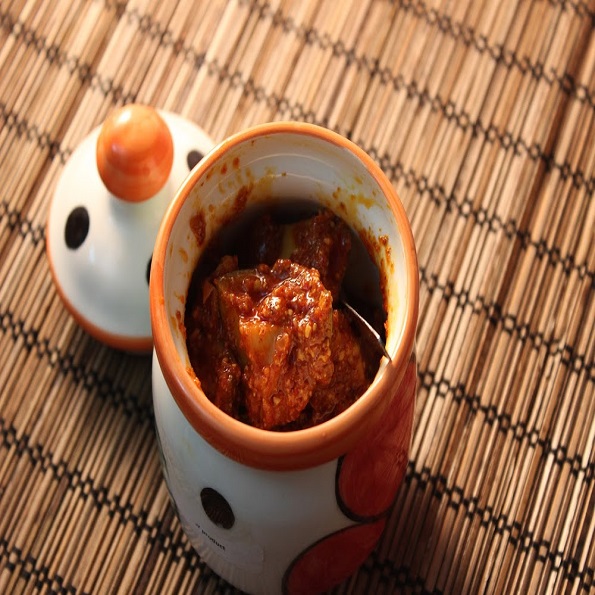“Old cookbooks and recipes are prized possessions. Flip through the pages and you will find a frugal approach to delicious cooking, a whispered confession of love through the spice stains, a master class in cooking and a sense of gratitude for how things are now.”
The following essay was published in the 7th issue of “The Forager Magazine“.
When I think of paati, I think of her bhel puri.
Two heaped cups of puffed rice
1 chopped onion
1 chopped tomato
1 carrot, grated
Chopped cilantro
A pinch of pepper powder
A pinch of chat masala, in the odd occasion we had it at home
A pinch of salt
About 2 tablespoons of ground nuts
Little bit of tomato ketchup
All mixed together and served on stainless steel plates.
This was paati’s version of bhel puri. Summer holidays were a strange mix of boredom and hunger, sometimes one overlapping the other without a clear distinction on what made us shout “want food now”. Paati had creative ways of answering these calls, making the best “kid pleasing” meals with what was around, a version of bhel puri included. Knowing what authentic bhel puri tasted like, I don’t know why I accepted this version and the plate she offered. Maybe it was because I wanted to gobble up the “puffed rice” medley before it became completely soggy. Or for the simple reason that it was delicious in its own strange way, and I felt that I had access to an imitative version of something exotic.
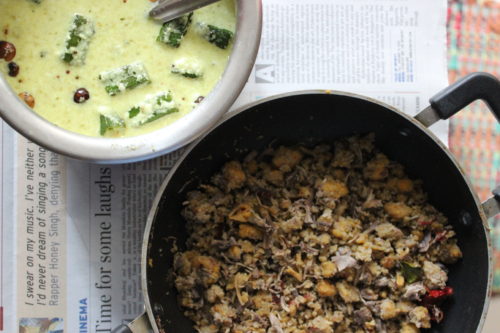
When I think of paati’s cooking, I think of how she made sure all the vegetables were cut size appropriate before the cooking started. I think of her potato cutlets. I think of how quickly she could roll laddus to perfect round shapes. I think of her love for tea and ice creams, and most of all I think of her bhel puri. She was an incredibly strong woman, who pulled herself and her family through the toughest of situations. Even when means were strained, she welcomed surprise visits from friends and relatives for an evening tiffin of dosa or upma (bajji’s and pakodas were for esteemed guests like sons-in-lawor older uncles) or a delicious lunch of her sambhar sadam and thayir pachidi. When I think of paati, I think of her bhel puri, because it depicted everything she was. Someone who was creative and well-travelled. Someone who loved eating out. Someone who found her way with what she had. Someone who never disappointed her family. For me this bhelpuri is now a family recipe.
In her book “Tiffin” Rukmini Srinivas recollects her Dr Chitappa making masala vadais. “Chitappa preferred to cook in the verandah. Sitting crosslegged on a slightly raised teakwood plank on the floor, he cooked on a kerosene Primus stove. Pumping it to a blue flame, he heated up the oil in the wok. While the oil was getting hot, he arranged the bowl of grounded batter, the metal colander, a slotted spoon and a smaller bowl of water next to his wooden plank. I sat on a reed mat on the floor, absorbed in one of my first lessons in the art of south Indian vegetarian cooking. I noticed he dipped his fingers in cold water, dried them on the kitchen towel which was neatly folded and resting on his right thigh, took a little of the mix, rolled it in his palm, then patted it lightly with his forefingers, scooped it up and gently slid it into the hot oil.”
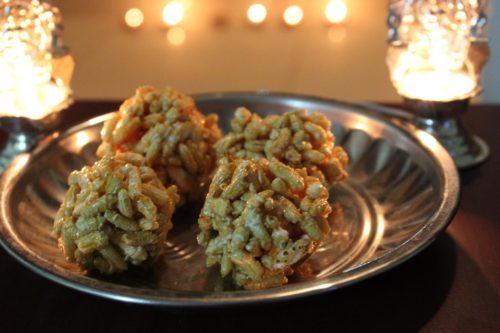
When you go back into your family looking for recipes, you realize you get more than just a set of instructions. You get a glimpse into personalities, a peep into their lifestyle and sometimes a better understanding of where you come from. The kerosene Primus stove, the wooden plank, the neatly folded kitchen towel are not an essential part of the recipe. Without them, it’s just the recipe of masala vadais and not Dr Chitappa’s masala vadais.
Yesteryears’ cooking was an art and an act of balance. It still is, but the parameters are different. A lot of factors affected the daily menu which varied from family to family. Cooking was influenced by day to day routine, the day of the week, the season, the presence or absence of a festival and the lunar calendar. My husband grew up in a joint family where food was cooked for at least 10 people every day. The meals were so well planned out that they made the best use of resources and the seasons. The Saturday menu included Thengai Thogayal for the simple reason that every Friday they would break fresh coconuts for the morning pooja. Summers meant time to grind the rice to a thick paste which was cooked and made into vadams. These would be sun-dried in the terrace as people took turns to keep an eye on them. Vadams would serve as accompaniments on days when they ran out of vegetables for a simple night time supper of Rasam Rice and Curd Rice. It was mandatory to use lentils on Tuesdays and Fridays, so a Monday menu would include a lentil-less Vathal Kozhambu to break the monotony.
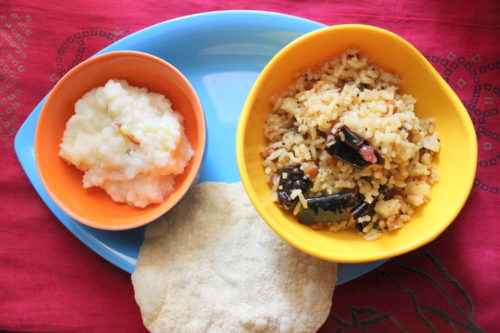
Cookbooks are not just mirrors to personality traits and daily routines, but also serve as valuable tools to understand agricultural, animal husbandry and food storage practices at large. Amy Guttman in her article “Three ways cooking has changed in the last 300 years” writes about food historian Annie Grey and Judith Finnamore’s attempt at recreating a collection of recipes written by British women between the years 1690 and 1830. Some interesting observations of this project include the frequent use of carrots and recipes that have an excessive number of eggs (as many as 30 for a cake). Carrots were a part of many recipes as they were available all year round. Eggs were smaller in size during this period, which is why we would not need as many today. It was also observed that cooking processes were more intense back then. For example, eggs had to be whisked for an hour.
Priya Ramkumar, grand daughter-in-law of S. Meenakshi Ammal who is the author of the iconic cookbook “Cook & See (Samaithu Paar)”, echoes this sentiment of cooking being a more laborious activity back then. The book first came out in 1951. Priya and her family manage the publication of this book, which is available in 3 volumes. Priya has also worked on adding two more volumes which have recipes suited to today’s cooking styles. Priya shared her thoughts with me over a phone call. “It is ironic that as processes in the kitchen have become more convenient, cooking is becoming more obsolete. Earlier recipes had labor intensive steps like sifting rice to remove stones, or hand pounding grains for powders. Today we have so many gadgets that ease out the processes, yet due to a lack of time and sometimes interest; many recipes of the past still seem too cumbersome. In the earlier days, there was no drudgery associated with cooking. Yes, they did have more time at hand, but they also enjoyed cooking and understood the significance of some of the practices.”
Cooking today lies anywhere between a form of art where you see a display of exotic ingredients and beautifully captured images, to a direct representation of our fast lives and our obsession with calorie counted meals. Cookbooks have adapted to this change and you see titles like “Meals under 60 or 30 minutes”, to “Calorie Counted Meals for the Family”. We are also bound by an ingredient and measurement specific approach. As much as I enjoy trying out new and old recipes, so far my preference has been recipes that are a set of clear instructions. On the odd occasion that I did ask someone in my family for a recipe, a word that would particularly haunt me was “Kannuthittam”, which means a visual approximation of the ingredients. Only when put into practice did I realize the importance of this step.
Kannuthittam is not meant to discard your pragmatic approach to cooking, rather make you realize that cooking something repeatedly helps you develop certain finesse. Earlier, meals were cooked for large families, in which case a very measured approach to cooking was not possible. “Add spice according to the amount of tamarind”, was an advice I heard repeatedly from the experts. Once you knew the number of people you were cooking for, you needed to balance out the ingredients to get that right taste. Something that came with practice.
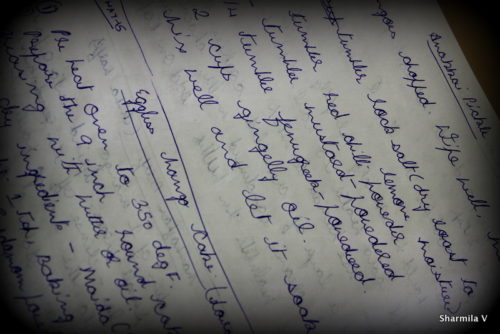
Old cookbooks and recipes are prized possessions. Flip through the pages and you will find a frugal approach to delicious cooking, a whispered confession of love through the spice stains, a master class in cooking and a sense of gratitude for how things are now. A global interest in this concept is seen in projects like the aforementioned recreation of the 300-year-old British cookbook, and a more recent one in Nashville Tennessee called “Dirty Pages”. Created by three food writers, the Dirty Pages exhibits recipes and related stories that are special to 20 cooks, who shared their memories.
I do not have any written recipes that my grandmothers left behind. Something that I intend to do from now on is to include my family more when I look for recipes. I have started writing these recipes down and hopefully; someday a stained version of this book will be of use to someone.
I made bhel puri the other day. I made the green chutney. I made the tamarind dates chutney. I made sure I had all the ingredients, even if it meant a separate trip to the store. I mixed them up in the right proportion. Everyone enjoyed it. I liked it. But, there was nothing distinct about it. I wondered what a dash of tomato ketchup would do it. I thought of paati. I thought of her bhel puri.
—>
Footnote:
Paati- Grandmother
Bhel puri- A popular street food
Laddus- Ball shaped sweets made with chickpea flour, semolina or grated coconut
Dosa- Savory pancake made of a rice and lentil batter
Upma- Semolina cooked with various vegetables
Bajji’s and Pakodas- Vegetable fritters made with chickpea flour batter
Sambhar Sadam- Rice and Lentils cooked with vegetables, ground spices and coconut in tamarind water
Thayir Pachidi- Onions chopped and mixed with curd
Masala Vadais- Fried lentil patties
Thengai Thogayal- Grated coconut ground with roasted spices and tamarind to a paste, which would be mixed with rice and eaten.
Pooja- Prayer rituals
Vadam- Sun dried rice crispies
Rasam- A South Indian soup usually made with a tamarind juice base, tomatoes and spices. Steamed lentils are also added.
Vathal Kozhambu- Thick tamarind extract boiled with spices and a little bit of jaggery, seasoned with fenugreek seeds and dried berries of “prickly nightshade” also known as sundakkai.
[1] Pori Urundai, puffed rice in jaggery syrup.
[2] A page from the recipe book.
[3] Avakkai, cut mango pickle.
[4] Akkaravadisal, tamarind rice and sweetened rice and lentils.
[5] Banana flower curry with lentils.
Sharmila Vaidyanathan writes about food entrepreneurship and the changing trends in the food sector on her website www.theyellowturmeric.com. She is based in Bengaluru, India and can be contacted at sharmila.vaidyanathan@gmail.com
All photos courtesy: Sharmila Vaidyanathan
